Caring for indoor plants is an endless topic, because each type has its own recommendations for watering, growing, propagating, and so on. But there are also general rules, knowing which you can always maintain your small indoor greenhouse in good condition. And then you will be able to make sure that the plants delight you with their invariably blooming buds and luxurious greenery. By the way, in addition to their external charm, they help create a special microclimate in the room, give the room comfort, and also have air disinfecting properties, such as geranium, chlorophytum, aloe, prickly pear cactus and many others. So what is required for quality care for them?
For the normal development of green pets, conditions are required that are close to their natural habitat. This article will talk about how to care for indoor plants, what their needs for moisture, light, air temperature and humidity are. It should be noted that they vary greatly depending on what kind of flower has settled on your windowsill. At the same time, some green pets are capricious, and you will have to tirelessly care for them, while others are so unpretentious that it is sometimes easy to forget about them.
On all four sides
The rules for caring for indoor plants consist of many points, but you need to start with where you place your green guest or visitor. When placing flowerpots with flowers growing in them in an apartment or house, you cannot proceed solely from the requirements of the interior. Of course, this is just a wonderful decoration, but it is alive and therefore worthy of settling where it will be comfortable. It is necessary, first of all, to take into account that experts recommend growing light-loving species, which include most plants, on windows oriented to the south, southeast or southwest, or in close proximity to them. Unfortunately, the north side is only suitable for shade-tolerant species that have only decorative foliage. They usually do not bloom.
In the back of the rooms - on bedside tables, cabinets and tables - you can place such unpretentious plants as ivy, begonia, tradescantia, monstera, fern, dieffenbachia, peperomia, asplenium, alocasia, fittonia, scindapsus, rubber-bearing ficus, arrowroot and so on. If they don’t have enough light, they will “tell” you about it themselves. Young shoots will begin to stretch, losing their rich color, and new leaves will be smaller than the old ones. With insufficient insolation, plant growth often stops. Therefore, if a flowerpot that was recently pleasing to the eye suddenly began to change before your eyes, think about whether its current unattractive appearance is connected with its transfer from one place to another, less lit place.
Many house flowers, especially those placed deep in rooms, suffer most from a lack of light on the short days of the autumn-winter period. Whether this happens to your pets is not so difficult to understand - just watch them. The leaves have changed color, turned yellow, the plant looks weak and sick, but do you notice any traces of pests or rot? Well, it is likely that keeping the room in its current location is not suitable for him. For those who want to know how to properly care for indoor plants, it is important to understand that in such conditions, and then only temporarily, only strong adult species with a well-developed root system can exist. Their lack of photosynthesis will be compensated by the consumption of previously accumulated organic matter.
For the winter, in any case, it is better to move all the plants to the window, and as close as possible, or use artificial lighting using fluorescent lamps, since they provide an emission spectrum close to the spectrum of daylight. If you decide to make a backlight for your green pets, know that in cloudy weather it will have to be turned on for twelve to fourteen hours, and on bright sunny days - only in the morning and evening in order to lengthen the duration of the light period. This type of care for indoor plants will provide them with optimal comfort. It is recommended to place an additional light source at a distance of at least fifteen centimeters from the crown of flowers. If you do not follow these recommendations and hang the lamp directly above them, you can cause a burn to the plant.
Gardening Tools
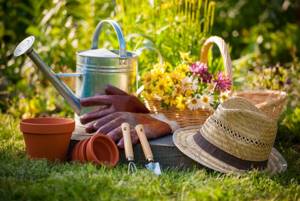
In the spring, before you start using your shovels or hoes, coat them with wax. If you do this, the dirt will come off easily and will not stick. Repeat this every month or so and the hoes and shovels will be easy to use.
Always wash gardening tools and store them in a cool, dry place. Spray metal parts with vegetable oil in late fall when you put away your tools for the winter.
If there are many flowers, but one window sill...
As for the window sill, on which most flowers are so comfortable, it should have the maximum possible width. The fact is that plants should not touch the glass with their leaves. In the summer, this can lead to burns, and in the winter, hypothermia. And flowers shouldn’t interfere with each other either, especially since there are species that your other green pets won’t like being in close proximity to. For example, it is better to place geranium separately - other plants do not like it.
But what to do if most of your flowers love light? Is it really not possible to place them all on the sunny side? More experienced housewives of home greenhouses came up with a solution. It consists of installing a special bookcase with shelves on the windowsill. Small flowerpots with violets look especially impressive on it. You get such a blooming miniature flower bed. In addition, it is not at all necessary to place the pots on the windowsill itself. They can be placed on special decorative stands on the sides of the window so that the sun's rays fall on the plants. Nowadays, in any themed store you can choose such a convenient item made from wicker, forged metal rods or other material.
Many housewives are concerned about the question of whether they need to turn plants towards the light. Experts insist on this need. But even in this case, there are important nuances: if you want to admire beautiful flowers, never move flowerpots and pots during the period when the plants are budding. For example, let’s take an unpretentious cactus. Did you know that nature has endowed it with one interesting feature - it drops already formed buds if the position of the plant itself relative to the light source changes sharply.
Yes, yes, imagine that such a long-awaited event as the appearance of a delicate flower surrounded by thorns may not take place only because you moved the cactus to another, better, in your opinion, place. By the way, this is just a defense mechanism, and not the capricious behavior of a whimsical pet. The desert is known to have very difficult survival conditions. Therefore, a plant torn out by a storm or knocked down by a camel’s hoof is forced to get rid of its buds and direct all its strength to take root again. Yes, when it comes to life and death, there is no time for beauty. As you can see, in the world of flora there are also laws similar to human ones.
Marigolds: secrets for caring for a sunny flower
With the onset of summer, all city flowerbeds turn into blooming sunny meadows. Small bushes of bright flowers that delight the eye from late spring until frost are marigolds.
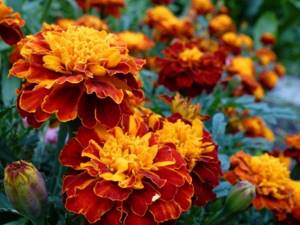
Quite unpretentious plants have become welcome guests on the plots of flower growers throughout the country. The homeland of marigolds is South America. These flowers have been known since ancient times, when the indigenous people of the American continent used them in their magical rituals. Marigolds were also used for medicinal purposes; the Indians brewed their own potions. Flowers were brought to the Old World in the 16th century. The plants came to Russia at the beginning of the 17th century and became one of the first plants imported from overseas. In Russia, marigolds have become very popular, and among flower growers they are called Chernobryvtsy.
The plants are branched bushes that look like an umbrella. There are two types of flowers: tall (130-150 cm) and short (30-40 cm). The stems and leaves are dark green, juicy in color, medium-sized flowers with a variety of colors (from light to dark brown, orange, yellow). Marigolds begin to bloom in early summer and continue flowering until frost. They are one of the last to leave the flower beds. You can often see a picture of yellow bushes standing under a cap of snow. Chernobryvtsi have a sharp, characteristic odor. This is why many gardeners plant plants between the beds of tomatoes and potatoes to repel pests. Marigolds reproduce by seeds, which retain good germination for 5 years. They also have the feature of self-seeding. Flower growers often notice flower sprouting in places where they were not sown.
Read: Growing astrantia in the garden
To grow spreading bushes with blooming lights from seeds, you don’t need any special wisdom. Even a novice florist can handle this task. The main thing is to decide what types of plants will be in the garden: tall or short. The choice of location depends on this. If you choose tall varieties, you must remember that the bushes grow over time and reach a height of 1.5 meters. It is also necessary to maintain a distance of about half a meter between the bushes. Low-growing varieties can be planted between trees and other flowers. They have enough space between the bushes of 25-30 cm. However, we must remember that sunny flowers love light, so there must be access to the sun. Otherwise, the plants will become very elongated and will bloom little.
You can first grow seedlings on a windowsill, or immediately sow seeds in open ground. Flower growers prefer the second option, which is less troublesome. Once the location has been chosen and the ground has warmed up, you can begin sowing. In a well-dug and looted bed, grooves are made with a hoe. The ground is well watered and the seeds are distributed. If you manage to spread the seeds not very densely, although this is difficult to do, since the seeds are very small, you can then not plant the plants. If the seedlings become too dense, it is necessary to thin out and replant. After the seeds are spread out, you need to water them and cover them.
Read: Chamomile and garlic against pests
The first shoots appear after 3 weeks. The first time after planting, the flowers need watering. But you can’t fill them. As the bushes dry out, water them strictly at the roots. After two weeks, the plants need to be watered with urea for enhanced growth. When the bush is formed and buds form, watering is reduced. Otherwise, there will be stagnation of water and the plants will wither. During the entire flowering period, marigolds are fertilized several times. The first time was when the bushes had just formed, the second time was during the period when buds appeared, and the third time was when flowering began. For feeding use any complex fertilizer. Periodically, the soil around the bush is loosened and weeds are removed.
Chernobryvtsy are rarely exposed to diseases and pest attacks. They are helped by the smell emanating from the leaves, which repels pests. In rare cases, they can get sick with gray rot, then the bush is pulled out and destroyed. When the flowers begin to dry, they are collected and laid out in the sun. After the fruits are well dried, they are collected in a bag and left until next year. Seeds should be stored in a dry, dark place.
Read: Dodder: a difficult to remove parasitic weed
It doesn’t matter which marigolds to choose: low or tall, yellow or orange. Any of them will delight the eye in the summer, and warm the soul in the cold autumn.
You might be interested in:
- Universal marigolds
- Patient marigolds
- How to sow flowers before winter
- Blue cyanosis - beautiful and useful
- Flowers with which I decorate my garden
- Ageratum carpet
Subscribe to our channel in Yandex.Zen
Fertile soil is a vital necessity
Houseplants must be replanted. It is advisable to do this in the spring every two years. This need is caused not so much by the fact that the plant is growing, but by the deterioration of the soil itself. Of course, nutrients can be replenished with fertilizers, but over time the soil changes its structure and becomes dense, making it difficult for the roots to reach oxygen. In addition, the soil changes its acidity and becomes clogged with salts that accumulate in it during watering.
Tips for caring for indoor plants contain one important detail: each type of house flowers needs its own soil, which includes various components. Turf and leaf soil, moss, peat, sand, bark, mixed in different proportions, are ideal components of a plant substrate. We have long been accustomed to the fact that flower shops sell ready-made soil, and we buy it for our green pets, believing that this is the best choice. Indeed, indoor plants that are not demanding on the soil composition feel good when transplanted; they usually do not show signs of soil rejection, rejection, and so on. But this doesn't always happen. Therefore, you need to figure out how to find on sale what your plants need.
It should be noted that fertilizers and plant soils are goods that are not subject to mandatory certification. Therefore, the contents of the packages may not at all correspond to the stated composition on the label. Moreover, many companies simply package purchased raw materials. You also need to be able to distinguish between the concepts of substrate and soil. The latter necessarily contains sand, which the roots need for comfortable growth. And the substrate is used to enrich open soils. All soils that are sold in stores are divided into two groups:
- Soils based on vermicompost. They are obtained by processing organic waste - sawdust, straw - with worms.
- Peat soils. They are made from light and fluffy high peat and fibrous lowland peat. High-moor peat is not capable of retaining moisture, while low-lying peat, which has a fibrous structure, is favorable for the root system.
Returning to the topic of replanting indoor plants, it must be emphasized that those bought in the store really need it. A light but cramped plastic pot that barely accommodates the root system and a handful of substrate are needed to ensure minimal weight during transportation. They are not suitable for the normal existence and growth of plants. In addition, in an apartment flowers find themselves in completely different conditions. And sometimes they have difficulty adapting to a new environment. That is why caring for them in the first months should be especially attentive and thorough.
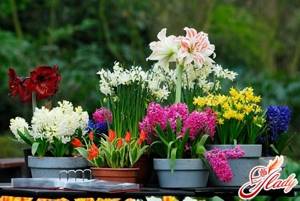
Spathiphyllum transplant
Spathiphyllum is transplanted into a larger pot as the earthen coma is developed. Mature plants no more than once every 2-3 years. Young - as necessary, but not more than once a year. If you recently purchased a plant in a seedling pot and a transport substrate, it is worth replanting it, or more precisely, transferring it without disturbing the earth as quickly as possible. Transshipment can be carried out even during flowering and regardless of the time of year. But you should not take a pot “to grow”, otherwise, until the plant covers the proposed volume of soil with its root system, it will develop slowly, which will also affect flowering. The next pot increases in diameter from the previous one by 2-3 cm, depending on the volume of green mass and the volume of the root system.
Soil for spathiphyllum
The most important condition for the soil composition of spathiphyllum is that it should not be heavy. A ready-made universal soil for indoor plants is suitable, to which it is advisable to add perlite or vermiculite (no more than 10% of the universal soil) and sphagnum moss. The key to success will be a good drainage system in the pot! That is, the pot must have a hole at the bottom and expanded clay is poured onto the bottom in a layer of 1-2 cm.
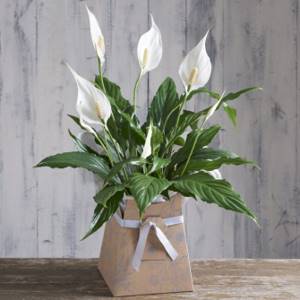
Reproduction of spathiphyllum
Spathiphyllum reproduces by dividing the bush, separating young rosettes and seeds. Seed propagation of spathiphyllum is difficult and unproductive. Because the seeds must be freshly harvested and sown in a sterile substrate. And even under favorable conditions, not everyone hatches. Dividing the bush is the fastest and easiest way to propagate. It is produced in the spring. But it is advisable to remove the flowers so that the plant does not waste energy on them.
Feeding calendar
Spathiphyllum is fed during the period of active growth and flowering once every two weeks. In winter, if the plant receives enough light, you can feed it once a month. Nothing will happen to the plant if you refuse to feed during the winter. Fertilizing should be for flowering plants. You can alternate the application of organic and mineral fertilizers. Fertilizers should only be applied to moist soil! After transplantation, the plant is fed no earlier than 1-1.5 months
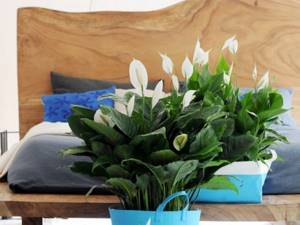
I hope that the secrets of caring for spathiphyllum described above do not look complicated and will not scare off an inexperienced gardener from purchasing this completely unpretentious (with proper care) plant.
Little secrets of experienced flower growers
Many indoor plants can be turned into neat and compact bushes, giving them a beautiful shape. The main thing is to know the basic principles of proper crown formation. To do this, it is necessary to promptly cut off strong and main shoots, the so-called “leaders”. The most painless way is to periodically pinch the tops, because cutting long and large branches weakens the entire plant as a whole. Especially if this happens in winter, which is a special time for green pets.
The life cycle of any indoor plants involves a dormant period. In this they are no different from their wild counterparts growing in the natural environment. For some, the dormant period begins during cold weather, and for others during drought. At this time, flower buds are laid. Before the onset of frost, in the fall, it is recommended to place hibiscus and azaleas on the balcony for a period of two weeks to a month. But representatives of bromeliads - echmea, gusmania - require a hot environment for the formation of flowers, when the temperature should not fall below twenty-five degrees Celsius, and preferably significantly exceed this figure.
If you are rearranging your house, you should not change the position relative to the cardinal directions of citrus ornamental plants, because their leaves are not adapted to rotate in response to the sun's rays. To control this, you can stick a stick into the ground on the north side of the pot as a guide.
You need to be able to pinch a homemade tangerine or lemon correctly, leaving three or four leaves on the young shoots. The tree then turns out to be compact, and its leaves are strong and large. With proper lighting, moderate watering and rest with a temperature range of ten to fourteen degrees Celsius, your plant will bloom the next year. A lemon grown from a seed will delight you with its first buds and will begin to bear fruit only after fifteen years.
As you can see, having the right content isn't everything. It turns out that it is not enough just to plant a child or buy a plant in a store and provide it with comfortable conditions. In some cases, you will have to be extremely patient to finally see the long-awaited buds or fruits on it. There are several more secrets on how to provide proper care for indoor plants. Here are the ones that may be useful to you:
- arrowroot and asplenium love moderate lighting and high humidity;
- Ficus Benjamin is very popular due to its unpretentiousness and decorativeness; it can be kept anywhere in the apartment;
- anthurium needs watering, it is shade-tolerant, but does not like waterlogging, so the flowerpot with it must have a layer of drainage;
- cypress is a sun-loving plant that needs moderate watering and a long cold dormant period;
- shade-tolerant scindapsus does not like abundant watering;
- azalea is a mountain plant, so its root system is superficial, it needs acidic soil, high humidity and abundant watering.
Of course, it is impossible to quickly comprehend all the subtleties and nuances. Growing a home greenhouse or even a couple of now fashionable orchids is a troublesome task that requires attention and patience. Even an unpretentious cactus will delight you with its surprisingly delicate bud only if its contents were correct. But we learn everything gradually, and the art of growing indoor plants is no exception. The main thing is patience, desire and the ability to use practical advice.
Source https://jlady.ru











